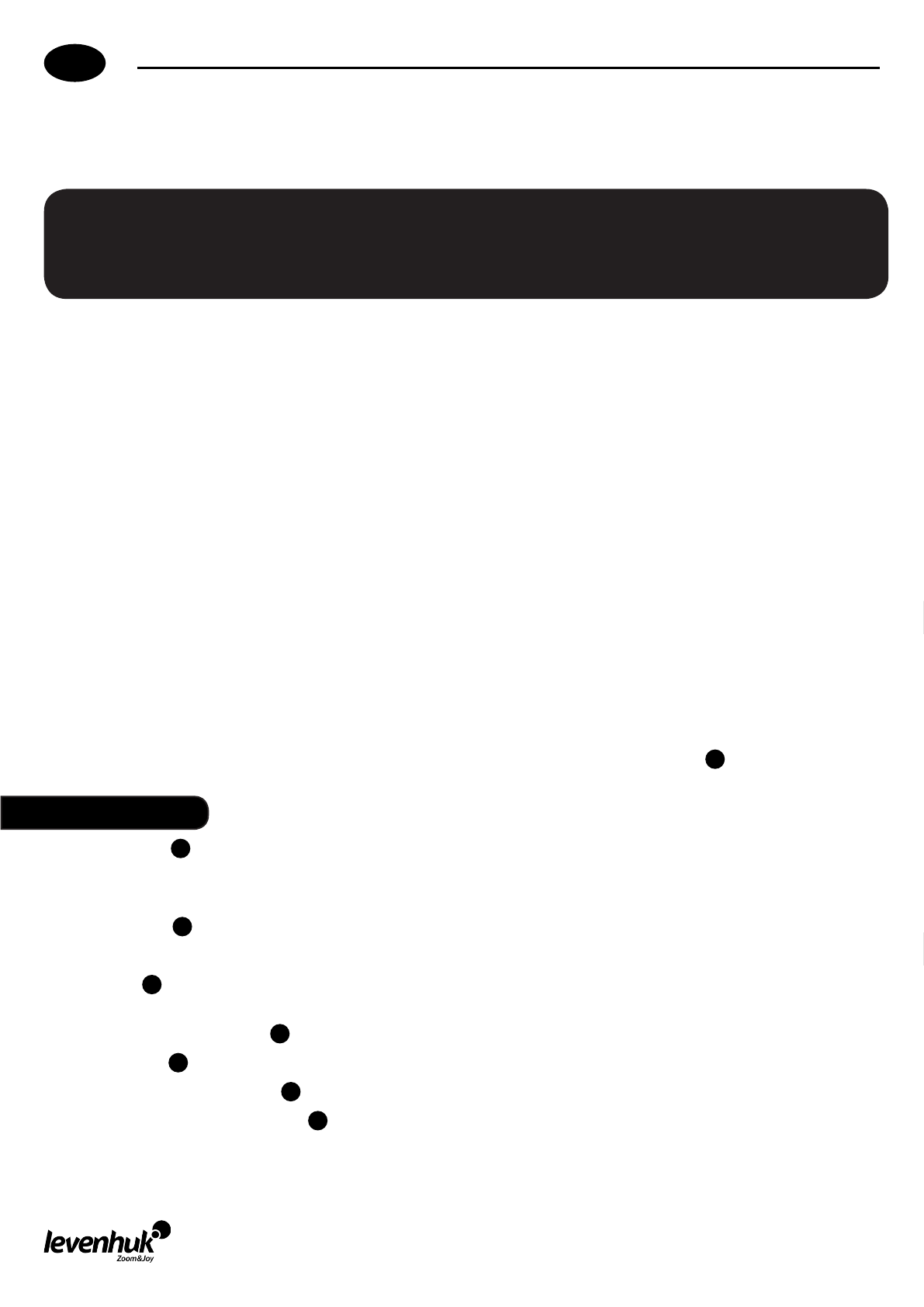Телескопы Levenhuk Strike 100 PLUS - инструкция пользователя по применению, эксплуатации и установке на русском языке. Мы надеемся, она поможет вам решить возникшие у вас вопросы при эксплуатации техники.
Если остались вопросы, задайте их в комментариях после инструкции.
"Загружаем инструкцию", означает, что нужно подождать пока файл загрузится и можно будет его читать онлайн. Некоторые инструкции очень большие и время их появления зависит от вашей скорости интернета.

4
EN
Levenhuk Strike PLUS Telescopes
EN
Red dot finder:
2
Used to locate objects before using the telescope tube.
Please note that the red dot finder has to be aligned to the telescope tube prior to any observations.
2x Barlow lens:
3
Used to double the power of any given eyepiece.
Eyepieces:
4
•
25mm eyepiece. Yields the lowest power, but the resulting images are the brightest
•
Zoom eyepiece F6.8-F16mm
5
Counterweight
6
Declination slow-motion control
7
Right ascension slow-motion control
8
Note: Levenhuk reserves the right to modify or discontinue any product without prior notice.
Accessories
Congratulations on your purchase of a high-quality Levenhuk telescope!
These instructions will help you set up, properly use, and care for your telescope. Please read them thoroughly before getting
started.
CAUTION! Never look directly at the Sun — even for an instant — through your telescope or finderscope w
ithout a professionally
made solar filter that completely covers the front of the instrument, or permanent eye damage may result. To avoid damage to
the internal parts of your telescope, make sure the front end of the finderscope is covered with aluminum foil or another non-
transparent material. Children should use the telescope under adult supervision only.
All parts of the telescope will arrive in one box. Be careful when unpacking it. We recommend keeping the original shipping
containers. In the event that the telescope needs to be shipped to another location, having the proper shipping containers will
help ensure that your telescope survives the journey intact. Make sure all the parts are present in the packaging. Be sure to
check the box carefully, as some parts are small. No tools are needed other than those provided. All screws should be tightened
securely to eliminate flexing and wobbling, but be careful not to overtighten them, as that may strip the threads.
During assembly (and anytime, for that matter), do not touch the surfaces of the optical elements with your fingers. The optical
surfaces have delicate coatings on them that can easily be damaged if touched. Never remove mirrors from their housing, or the
product warranty will be null and void.
It is important to properly assemble your telescope in order to allow it to function properly. Take the time to become familiar
with your new telescope. Learn the names of the various parts, where they are located and their function. It is the best to
perform these functions during the day time. When setting up for a viewing session, place the telescope in an area sheltered
from the wind if possible. The best night time viewing will be away from city light and when the atmosphere is «steady». With
a little practice you will learn to judge when viewing conditions are good. Look for the nights when the stars shine brightly with
little or no twinkling.
Consider using the telescope for earth (terrestrial) viewing before attempting to view astronomical objects. This will familiarize
you with how powerful each eyepiece will be, as well as introducing you to the functions of your accessory lenses. We
recommend you begin with the lowest power eyepiece, 25mm, when using your telescope. As you increase the power, the image
will appear darker; this is due to the basic physical properties of the telescope. The higher the power you use the darker the
image will appear and your viewing field will be narrower. Please be patient when using your telescope. It is a very sensitive
instrument that is capable of using high powers. However, the more power you use, the more sensitive the telescope becomes.
As a result, the slightest movement of the telescope could cause you to lose the image you have in your eyepiece. Practice will
enable you to know how much movement to expect with each eyepiece and its corresponding power.
1
Содержание
- 30 ) Электронный искатель с красной точкой; Аксессуары; Телескопы Levenhuk Strike PLUS
- 31 ) Ручка тонких движений по оси склонения; Сборка
- 32 Модель; Использование линзы Барлоу; Балансировка трубы
- 33 Балансировка трубы по оси прямого восхождения; Установка полярной оси
- 34 Технические характеристики
- 35 пожизненная гарантия; Международная гарантия
- 44 оптическими приборами.; Засоби догляду за оптикою Levenhuk; оптичними пристроями.; Radost zaostřit













































